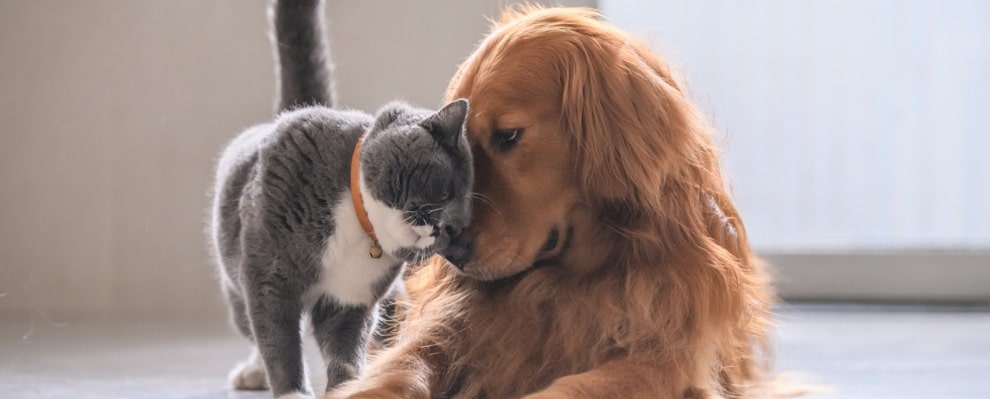Search Programs
When you click on a sponsoring school or program, or fill out a form to request information from a sponsoring school, we may earn a commission. View our advertising disclosure for more details.

“People have to realize that dogs and cats don’t necessarily have a specific language that’s geared towards people. They use their own inherent language just like I would use English or a French person would use French. A lot of their communication is body signals or body language.”
Dr. Leslie Sinn, DVM
Often, it can feel possible to carry on a conversation with the furry members of the household. But is that what is really happening? Dr. Leslie Sinn, a veterinarian and animal behavior expert, says it’s a little more complicated than one might think.
“Humans, unfortunately, often overlook a number of what to us are very subtle signs but which to the animals are very obvious signs,” says Dr. Sinn.
In fact, when it comes to dogs, people are actually not very good at reading their signals: “People are notoriously bad at reading dog’s body language,” says Dr. Sinn. “You would think that if you’re an experienced dog owner, or if you’re a professional or a veterinarian or a dog trainer that somehow you would be better at reading dog language. Actually, it turns out that having that background confers no added ability to people being able to read dog body language. But there are certain individuals in each group who are good at it, but it appears to be an individual awareness versus a skill that’s a part of your background or experience.”
So, if we are bad at reading an animals’ primary language, how do they communicate with us? Keep reading to learn more.
Meet the Experts

Katherine Albro Houpt, VMD, PhD
Dr. Katherine Houpt is an emeritus professor at Cornell University College of Veterinary Medicine and is board certified by the American College of Veterinary Behaviorists. While her research primarily focuses on equine behavior, she has also completed considerable work with domestic animals.
Recently, she was a co-author on a paper on the variations in feline vocalizations that was published in the Journal of Veterinary Science. She is also the author of the veterinary school textbook Domestic Animal Behavior for Veterinarians and Animal Scientists, which is now in its sixth edition.

Leslie Sinn, DVM
Dr. Leslie Sinn is a veterinarian in Ashburn, Virginia. She is also a Certified Professional Dog Trainer-Knowledge Assessed (CPDT-KA) and board-certified by the American College of Veterinary Behaviorists. In addition, she has completed over 400 hours of postgraduate studies in animal behavior and psychology.
Her primary work is helping people manage behavioral issues with their pets. She earned her doctor of veterinary medicine degree from the University of Georgia and is a former assistant dean and professor at the Veterinary Technology Program at Northern Virginia Community College.
What is Animal Communication?
When starting a conversation about how animals communicate with us, it is important to define animal communication. “They do use some vocal signals, both to each other and to us. And they use a lot of body language. They also use olfactory communication, which we usually do not. That’s a sense of smell such as dogs mark with urine and cats even more so,” says Dr. Houpt.
However, communication with animals is not one way. While the ways they communicate with us seem obvious, we may not always realize the ways in which we communicate to animals.
Many things that we do every day around our pets communicate with them. “They’re very adept at reading facial signaling and body language. They respond to things like pointing and to things like voice tone, also to hand gestures. They’re very attuned to us. They notice all of those seemingly minor signs that we use in terms of communication,” says Dr. Sinn.
Why Do Cats and Dogs Communicate With People?
According to Dr. Houpt, animals communicate with us for a pretty basic reason. “What research has found is that if the dog wants something from us, they will almost innately signal to us. So all you have to do to see this is to take a treat, show it to the dog, and then put it out of its reach. Then, watch what the dog does. Most dogs will look at the treat, then look at you, then look at the treat and then look at you. They are certainly communicating, and you don’t really have to teach them that. It seems to be innate,” she says.
Dr. Houpt says that dogs tend to be better and more vocal about their communications with humans. “A dog will bark if it’s left by itself. For example, they go woof woof woof. If someone’s at the door, they go, rawr rawr rawr. If they want to play, they have a play bark.”
In general, people can tell what a bark means, particularly if they have owned a particular dog for a long time. “They found that people are pretty good at deciphering dog vocalizations. So a person who has been around dogs is usually able to tell the difference between a distress bark versus a play bark. However, different barks aren’t consistent amongst a single species. It is very dog to dog dependent,” says Dr. Sinn.
Animal Language Evolution
Language with domestic animals hasn’t been static and has evolved considerably over time. Dogs and cats were domesticated for their usefulness to humans. Dogs were domesticated first for their ability to protect humans. Cats were domesticated later, once humans started storing crops and grains and they needed help keeping rodents out.
The primary innate language of communication for most animals is through body language and not vocalization. “They have learned over time that vocalizations are effective for getting your attention. When they whimper, you’ve come running, or when they are bored, you provide them with a toy. And so that is a learned association,” says Dr. Sinn.
In fact, as a product of domestication, cats and dogs have developed methods of communication that differ from the ones they use with each other. One great example of this is with wolves, says Dr. Houpt. “Wolves don’t bark, for example, or I should say they very rarely bark. They’re closely related to dogs, but they don’t use the dog’s main form of communication,” she says.
Cats have also evolved language that is specific for humans. One place where this can be observed is in their vocalizations. “A meow in cats is actually a sound that cats use specifically cat-to-people versus cat-to-cat,” notes Dr. Sinn.
“Cats do not meow at each other. They only meow at people. If a cat is in a shelter, often personnel try to determine if the cat comes from a feral background, meaning it has never been around people, versus a cat that has been in a home environment and is now a stray. To do this, staff observe if they meow or not. If a cat will meow out at people, the assumption is it had contact with people at some point,” says Dr. Sinn.
Overall, dogs have evolved more complex communications with people both through vocalizations and also through body language. According to Dr. Houpt, through centuries of co-evolution with domesticated dogs, they have become increasingly attuned to human body language. “Wolves can’t do it, so it is apparently through domestication that [dogs have] become very attuned to human body language. Gestures have a great deal of significance to dogs, and they’ve learned to interpret them,” she says.
In fact, recent research published in the journal Current Biology has found that a dog’s ability to read human body language is not always a learned trait but rather an innate one. The researchers found that eight-week-old puppies understood what it meant when a human pointed at something, and then they subsequently followed the signals. This was even true of puppies that spent little time interacting with humans.
“We have a working relationship with dogs that we don’t have with other species of animals. They’ve been with us for thousands of years, so the thought is that, over time, we’ve selected individuals that are very aware of our signaling and have developed some translating abilities,” remarks Dr. Sinn.

